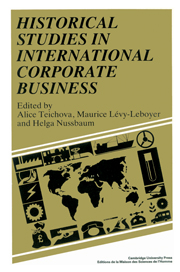Book contents
- Frontmatter
- Contents
- Preface
- 1 Introduction: multinational enterprise
- 2 History, the social sciences and economic ‘theory’, with special reference to multinational enterprise
- 3 The changing form of multinational enterprise expansion in the twentieth century
- 4 Electrical research, standardisation and the beginnings of the corporate economy
- 5 The nature of multinationals, 1870–1939
- 6 International price maintenance: control of commodity trade in the 1920s
- 7 Financial operations of US transnational corporations: development after the Second World War and recent tendencies
- 8 Multinational enterprise – financing, trade, diplomacy: the Swedish case
- 9 Foreign penetration of German enterprises after the First World War: the problem of Überfremdung
- 10 International industrial cartels, the state and politics: Great Britain between the wars
- 11 Vickers and Schneider: a comparison of new British and French multinational strategies 1916–26
- 12 J. & P. Coats Ltd in Poland
- 13 Multinationals and the French electrical industry, 1889–1940
- 14 The Japanese cotton spinners' direct investments into China before the Second World War
- 15 Mitsui Bussan during the 1920s
- 16 Japanese business in the United States before the Second World War: the case of Mitsui and Mitsubishi
- 17 The state and private enterprise in the United States–Latin American oil policy
- 18 Transnational corporations and the denationalization of the Latin American cigarette industry
- 19 Summary: Reflections on the papers and the debate on multinational enterprise: international finance, markets and governments in the twentieth century
- Index of names
- Index of firms
- Index of subjects
11 - Vickers and Schneider: a comparison of new British and French multinational strategies 1916–26
Published online by Cambridge University Press: 04 August 2010
- Frontmatter
- Contents
- Preface
- 1 Introduction: multinational enterprise
- 2 History, the social sciences and economic ‘theory’, with special reference to multinational enterprise
- 3 The changing form of multinational enterprise expansion in the twentieth century
- 4 Electrical research, standardisation and the beginnings of the corporate economy
- 5 The nature of multinationals, 1870–1939
- 6 International price maintenance: control of commodity trade in the 1920s
- 7 Financial operations of US transnational corporations: development after the Second World War and recent tendencies
- 8 Multinational enterprise – financing, trade, diplomacy: the Swedish case
- 9 Foreign penetration of German enterprises after the First World War: the problem of Überfremdung
- 10 International industrial cartels, the state and politics: Great Britain between the wars
- 11 Vickers and Schneider: a comparison of new British and French multinational strategies 1916–26
- 12 J. & P. Coats Ltd in Poland
- 13 Multinationals and the French electrical industry, 1889–1940
- 14 The Japanese cotton spinners' direct investments into China before the Second World War
- 15 Mitsui Bussan during the 1920s
- 16 Japanese business in the United States before the Second World War: the case of Mitsui and Mitsubishi
- 17 The state and private enterprise in the United States–Latin American oil policy
- 18 Transnational corporations and the denationalization of the Latin American cigarette industry
- 19 Summary: Reflections on the papers and the debate on multinational enterprise: international finance, markets and governments in the twentieth century
- Index of names
- Index of firms
- Index of subjects
Summary
In a recent study Claud Beaud has shown how the French armaments company, Schneider, acting with the Banque de l'Union Parisienne in the Union Européenne Industrielle et Financière (UEIF) which they formed jointly in 1920, made large industrial investments in the ruins of the Habsburg empire, their acquisitions including the Škoda Works and Bergund Hütten werksgesellschaft in Czechoslovakia, Veitscher Magnesit Werke of Austria, the Huta Bankowa group in Poland, and the Hungarian General Credit Bank. Beaud characterised Eugene Schneider's new strategy in Central Europe as an extension of his previous Russian initiatives, rather than as comparable to his other major multinational enterprises after 1898 in Switzerland, Italy, Spain, Morocco and South America. As Schneider ‘had staked technology rather than capital’ in the Putilov arsenal project before 1914, he was not chastened by its failure, and believing ‘the Bolshevik régime to be on the verge of collapse’, envisaged Škoda as ‘the arsenal of the Little Entente, replacing or even complementing Putilov’. Beaud suggests that development of his company's East European markets was a ‘secondary’ strategic motive for Eugene Schneider (1868–1942), who ‘desired to play a part, in some way, in increasing France's greatness… [during] the time of the “Bloc national” when the superior interests of the nation overrode the short term economic goals of a firm’.
- Type
- Chapter
- Information
- Historical Studies in International Corporate Business , pp. 123 - 134Publisher: Cambridge University PressPrint publication year: 1989

